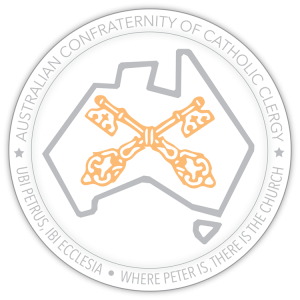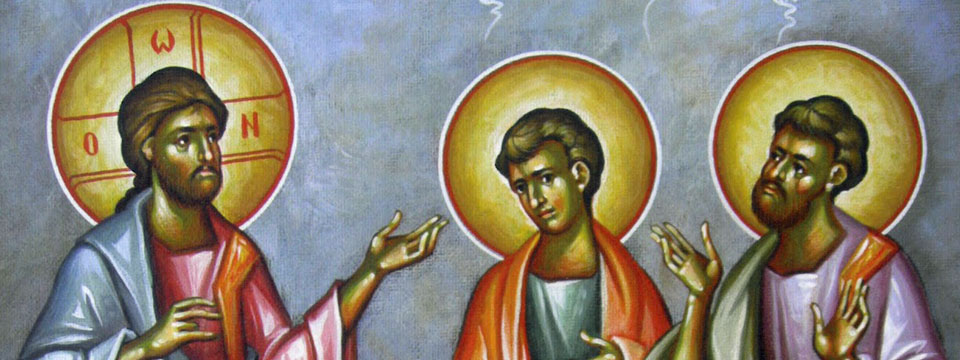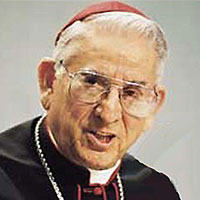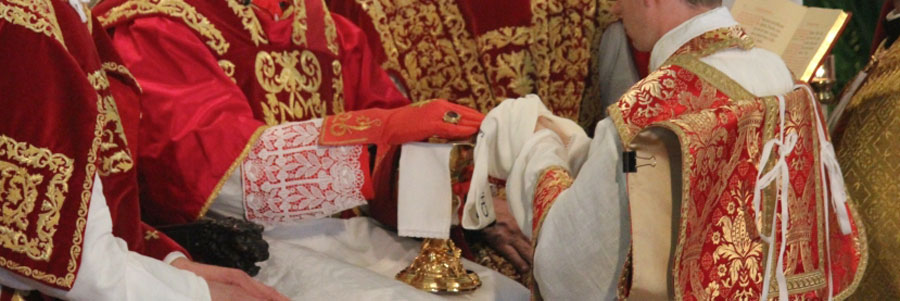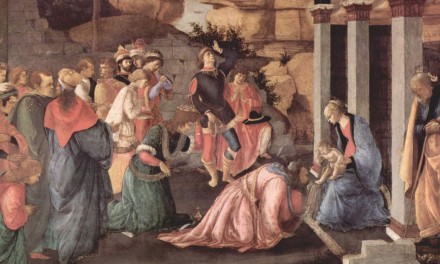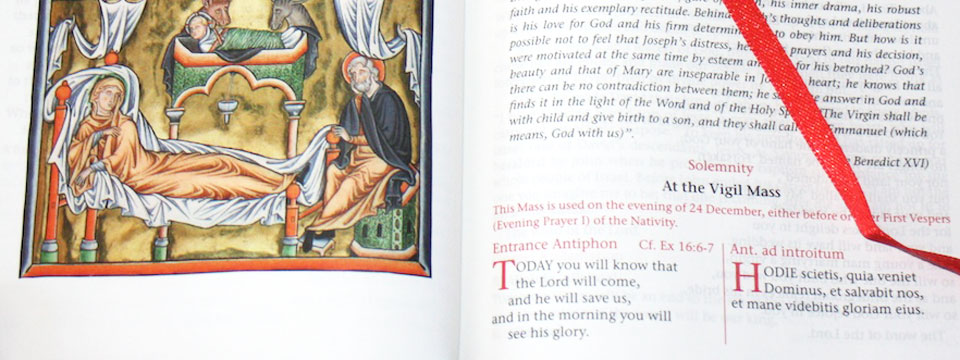Rabbi: You are the Son of God. You are the King of Israel. (Jn 1:49)
This brief but resounding confession of faith by the apostle Nathaniel gives us the basis for Christ’s mission: his divine sonship. He is the Word Incarnate. This is one of the two hinges on which today’s liturgy swings: the revealed truth about the Son of God. The other hinge is charity: God loves us so much that he pours himself into us, and because of the dynamics of his love, he asks us for a similar response of self-giving. The full accomplishment of charity in truth — caritas in veritate — is the goal of God’s plan of salvation; that is, participation in God’s life in Christ Jesus.
In his latest encyclical, the Holy Father reminds us that “in Christ, charity in truth becomes the Face of his Person.” (Caritas Veritate.) Thus Our Lord is the fulcrum of all salvation history and the source of holiness.
In the context of the Year for Priests, I want to reflect with you, my dear brothers in the priesthood, on the priestly identity, which in an analogous way also swings on those two hinges: the truth that we are ministers of the Lord, and the charity that must inspire all we do as priests.
The truth of our priestly ordination
In the Gospel we heard the vocation of two of the Apostles; we see how Our Lord sets some men apart for a very specific calling. The author of the Letter ot the Hebrews tells us that “every high priest taken from among men is ordained for men in the things that pertain to God” (Heb. 5:1). Now this expresses the nature of priesthood as mediation, an aspect of the ministry formally established by the sacrament of Orders. Therefore those who are configured as partakers in Christ’s priesthood “can act in the person of Christ the Head.”{{1}} And so the words Saint Paul addresses to the Corinthians regarding the shepherds of the community enter into their full meaning: “Let a man so account of us as of the ministers of Christ and the dispensers of the mysteries of God.” (1 Cor 4:1)
A priest’s identity, then, goes through sacramental identification with Christ. It is an ontological identification, but it is meant to acquire perfection in the ordained minister when he truly and lovingly lives this gift in obedience to God’s will. The Incarnate Word did not shun this aspect of human nature; he too was faithful and obedient to the Father’s will, and so, “he became, to all that obey him, the cause of eternal salvation” (Heb. 5:9). Following his Master’s lead, a priest perfects the gift he has received by lovingly fulfilling the will of God that the duties of his state, the regulations of the Church, his Bishop, and private prayer make known to him.
While seeking God’s will, a priest knows that it is always absolutely necessary to keep in mind that his calling is a gift from God. Jesus has called us, his priests, from all eternity to be united in his one priesthood, since he alone is Ruler, Teacher, and Sanctifier. This does not change, it is the essence. Union with Christ is the core of a priest’s identity and mission, as the Lord himself warned before ending his mission among us: “He that abides in me, and I in him, the same bears much fruit: for without me you can do nothing.” (Jn 15:5) Without this union we are dried-up branches, with nothing to offer today’s world.
Charity: a priest’s life
The truth that the priest is an ordained minister lies in his union with Christ, accomplished on a sacramental level. But this union is completed and renewed through the work of the same priest.
Priests work as another Christ: since “by the power of the sacrament of Orders, in the image of Christ the eternal high Priest, they are consecrated to preach the Gospel and shepherd the faithful and to celebrate divine worship, so that they are true priests of the New Testament.”{{2}} Though the source of holiness is God’s love, a priest should spare no efforts in making sure his work and each and every action reflect this love. Today’s Liturgy of the Word reminds us of this: “For this is the declaration which you have heard from the beginning, that you should love one another.” (1Jn 3:11)
Priestly charity is also essential to a priest’s identity because priesthood entails a particular identification with the love and mercy of the Good Shepherd, who gives his life for his sheep. It is a love that cannot help but spread, that cannot help but give itself to others in priestly ministry. At the start of his pontificate, the Servant of God John Paul II recalled the idea when he spoke to the priests of Rome:
The priest won over by the mystery of Christ, is called to win others over to this mystery …; he is called to help others to become a community…. In this way, the commitment with which the priest … builds the Church becomes the measure of his holiness.{{3}}
And what is holiness but the living of priestly charity, a taking part with God’s life in Christ? A priest’s identity is therefore also anchored in identification with Christ the Priest through good works. This is what we just read in the first reading: “Let us not love in word nor in tongue, but in deed and in truth. In this we know that we are of the truth and in his sight [we] shall persuade our hearts.” (1 Jn 3:18f)
Sacramental unity; plurality of pastoral action
Earlier we referred to the two hinges on which priestly identity depends: truth and charity. We can say that they are expressed respectively in the sacramental unity of the priesthood and the union of our wills with Christ through our acts.
Union with Christ is the fulcrum of priestly identity, and each priest’s union with Christ is also the bond that unites all who partake of the priestly order. In its turn, this unity of priests gives rise to a rich plurality of ministry.
It is true that priesthood is received in the Church and for the Church, but there is not a doubt that each priest builds the Mystical Body of Christ from a different position, according to the gifts that God gives him and the place that Providence assigns him. Some are parish priests, others are seminary formators as theology professors or spiritual directors, others are vicars for their diocese and counsellors to their bishops, and so on. The key is that this plurality of priestly charisms works as “yeast in the dough” in the living of brotherly charity and unity in pastoral work.
Charity that works in truth
Dear brother priests, during this Year for Priests we are invited to renew our awareness of our identity, to strengthen our union with our Lord, and to live charity in the plurality of our ministry. We are bearers of a great truth, and the world thirsts deeply for it: the truth of Jesus Christ, the Son of God who became man out of love for us, who offers himself in sacrifice to the Father so as to redeem us. We are vessels of clay who desire to bring God’s mercy and love to souls whom the Lord of the harvest has entrusted to us.
The Holy Father affords us a beautiful summary of this task in the letter.
In Jesus, person and mission coincide: all Christ’s saving activity was, and is, an expression of his filial consciousness: which from all eternity stands before the Father in an attitude of loving submission to his will. In a humble yet genuine way, every priest must aim for a similar identification. Certainly this is not to forget that the efficacy of the ministry is independent of the holiness of the minister; but neither can we overlook the extraordinary fruitfulness of the encounter between the ministry’s objective holiness and subjective holiness of the minister.{{4}}
Faithful dispensers: truth and charity
Christ is present among us, and he is alive in the mystery of the Eucharist, to which our priesthood and the whole life of the Church is ordered. Let us be faithful dispensers, then, of this truth and this charity.
I make my own the desire our Holy Father expressed in the start of the Year of Priests: “May this year help deepen the commitment of all priests to interior renewal, so that your witness to the Gospel may be stronger and more incisive in today’s world.”{{5}}
Let us invoke the aid of the Blessed Virgin Mary and contemplate her as the most perfect model of Christ’s redemption. May she, Mother of the eternal High Priest and Queen of the Apostles, make all of us priests more like her Son, Jesus, dispensers of the priceless treasure of the Good Shepherd’s love. Amen.
[[1]]Vatican II, Presbyterorum Ordinis, “Decree on the ministyr and life of priests,” n. 2.[[1]]
[[2]]Vatican II, Lumen Gentium, “Dogmatic Constitution on the Church,” n. 28.[[2]]
[[3]]John Paul II, “Address to the parish priests and clergy of the diocese of Rome,” Friday 2 March 1979, n. 2.[[3]]
[[4]]Benedict XVI, “Letter proclaiming a year for priests on the 150th anniversary of the dies natalis of the Curé of Arts”, Vatican City, 17 June 2009.[[4]]
[[5]]Ibid.[[5]]
